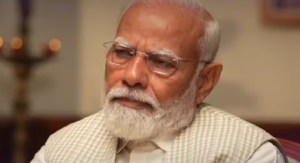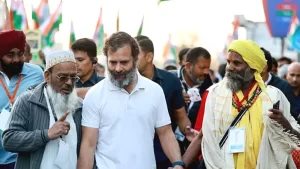For weeks now, everyone in India has been speculating about the outcome of the country’s general elections, hunting for clues on media outlets, studying past trends and crunching numbers from election databases.
Their conclusions have depended on which side of the grand ideological divide they stand – for or against the Hindu majoritarian regime of Narendra Modi. The polarization is such that it is impossible to believe big media or exit pollsters, who have already declared the incumbent government re-elected, much before the results are out.
The truth is that in this election, given the absence of any explicit political wave, nobody can really tell which way the verdict will go. There are too many factors that could prove decisive.
There is one thing that can be said with certainty though. India as we have known for the last three decades will not be the same after the 4th of June. Irrespective of the outcome –– there are clear signs the country is entering a new, more turbulent era and also one shifting away from the politics of the recent past.
There will be much pain and suffering ahead but also possibilities of great hope for a better India. While not exhaustive, here is a list of trends that are visible, some faint and others pronounced, in the 2024 season of the Great Indian Elections:
The Modi bubble is about to burst
Yes, this despicable charlatan, who rose to the nation’s top job using everything from communal poison, corporate cash and brazenly corrupt practices, is headed to the dustbin of history.
In this election we saw clearly how vast sections of Indians have snapped out of the spell cast on them for long by his devious manipulation of religious/nationalist sentiments and harnessing of hatred against the country’s Muslims and Christian populations.
This is especially true among the youth – who form the largest demographic section in the country – and who are tired of fighting battles from the imagined past or be used as pawns of power-hungry demagogues. All they want are decent, secure jobs and upward social and economic mobility. The rest of the country, made up of other age groups, craves peace and harmony in society to get on with their lives without worry.
Even if Modi worms his way to a third term the victory will be very short lived and the growing swell of discontent against his regime’s failed policies will only accelerate. We are entering a period of intense social mobilization and agitations that will transform Indian politics and society.
However, we do know that Narendra ‘Bonaparte’ Modi will not leave the throne so easily – as he has simply too much to lose or hide. Hence the apprehension about social and political turbulence ahead. There will be many Pulwamas post the Fourth of June for sure.
The Hindutva phenomenon has peaked
The ideological and organizational push for promoting Hindutva, the RSS idea that India should abandon secularism and openly adopt Hindu majoritarian rule, has exhausted its appeal. What started in the early nineties with L.K. Advani’s rath yatra, the demolition of the Babri Masjid and the capture of the Indian state machinery through the BJP’s ascent to power in 2014 – has lost its momentum.
Both the BJP and RSS are deeply corrupted by the same power they sought for long and finally achieved. They are shedding dedicated or motivated cadre (motivated by a dystopian vision of India) faster than fur off a sheep’s back in summer.
No, Hindutva is not going to disappear anytime soon. Like Covid-19 it will lose virulence but still hang around in the ecosystem, afflicting the very aged or those with weak immune systems. However, its ability to infect new followers or frighten people into submission is gone – in a few seasons it will be just another virus in the seasonal flu mix.
Among other reasons, this decline is due to Narendra Modi himself. While he played a key role in popularizing the appeal of Hindutva and establishing its political and social hegemony he is also the one responsible for undermining its future. In his self-appointed role as the prophet receiving messages directly from the paramatma he has become vastly larger than the parivar he came from.
Today, there are enough indications that the knives are out for Modi – within the Bharatiya Janata Party and Rashtriya Swayamsevak Sangh, both of which are hurting due to his transition from being their mentee to becoming their tormentor.
There is no doubt that the RSS will have to dump Modi at some point of time for its own long-term survival. The only question is whether it will be a golden handshake or the royal boot that will do the job.
The Indian Left is in for a grand revival
No, I am not talking about the established Left parties] here. The biggest leftist thinker and leader to emerge in many decades on the Indian landscape is none other than Rahul Gandhi, the feisty leader of the Congress party.
In the past year or so Rahul has managed to turn the national discourse firmly away from the theme of Hindu-Muslim divisions and brought issues of wealth inequality, livelihood, better wages for workers, welfare of the poor and improved farmers’ incomes to center stage.
Even more significantly, Rahul has brilliantly synthesized a convincing framework of class, caste and constitutional values, that has eluded Indian communist parties as well as purely caste-based parties in India all these decades. By calling for wealth redistribution, a national caste census to expand reservations and staunchly defending the Indian Constitution – he has skillfully fused the eclectic trinity of Marx, Periyar and Ambedkar together like no mainstream political leader has even attempted in the past.
Of course, how far these ideas will be taken up by the Congress party, given its mixed history, is a moot question. There is no doubt though, these concepts have struck a deep chord within the broader Indian population, in particular among the poor, Dalits, backward castes, women and religious minorities.
The next decade is surely going to be dominated by anyone who can organize the awakened masses effectively around this radical, social and democratic vision.
Indian Democracy is not going to die anytime soon
There have been relentless attacks made on Indian democracy and grievous injuries inflicted on its structures in the past decade all through Narendra Modi’s reign.
However, democracy in any society is not merely about symbolic set of institutions to be worshipped like a deity, but a dynamic, living process that involves constant, relentless efforts against dictatorship. In that sense democracy can never die anywhere because at the very core it is the struggle against injustice, oppression and the establishment of monopolies over power and resources.
The 2024 election campaign demonstrated how, despite all the odds stacked against them, the Indian opposition not just fought back but even expects to upend the Modi regime at the polls. This is a clear sign that democracy is still alive and kicking and a great portent for the future.
At a more basic level, democracy will assert itself also in the form of the fight for greater share of national resources by India’s armies of the unemployed, workers, women and farmers. The farmers movements of Punjab and Haryana are only a trailer of what is possible and what is likely to come ahead.
There will also be growing resistance to Hindutva and the BJP’s insistence on homogenizing India – One Nation, One Election, One Religion, One Party, One Leader. Pushback will come from states around the country wary of Delhi concentrating too much power – the battle for a truly federal India will intensify.
It will come from various linguistic groups around the country against the imposition of Hindi. An even bigger revolt waiting to happen is by diverse spiritual and religious traditions against being clubbed as ‘Hindus’ and denied recognition of their own unique religious or spiritual practices.
The 2024 electoral battle is only a short warm up session and the big fight remains, to defend the values, principles and legacy of the Indian Republic that were forged during the freedom movement against British colonialism.
What is heartening today is that, faced with the most evil and ruthless dispensation in modern Indian history, there are sufficient number of Indians rising to the challenge. They are showing the courage and capacity needed to launch the second historic struggle for India’s freedom.
No matter what happens on the Fourth of June we must all join them.
(Satya Sagar is a journalist and public health worker. Courtesy: Countercurrents.org, an India-based news, views and analysis website, that describes itself as non-partisan and taking “the Side of the People!”. It is edited by Binu Mathew.)




